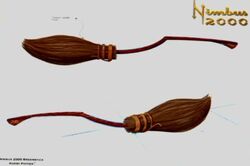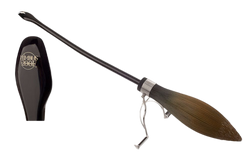Beginner’s Guide to Flying
This book will teach grade 1 students about flying.
Last Updated
10/02/22
Chapters
5
Reads
702
History of Broomsticks
Chapter 3
History of Broomsticks
Since no spell was devised by wizards to enable them to fly (with the exception of Lord Voldemort in 1997, and Severus Snape a year later) they had to come up with another way to do so. Animagi who transformed into winged creatures enjoyed the sensation, but they were rare.
Long before the International Statute of Wizarding Secrecy came into force, wizards were savvy enough to realise that Muggle neighbours would seek to exploit their abilities. Therefore, if they were to keep a method of flight in their homes, it would have to be unobtrusive and easy to hide. The broomstick was ideal — it was portable, cheap, and required no explanation. However, the first broomsticks were uncomfortable.
The first brooms

A Medieval Broomstick
Records showed that witches and wizards in Europe were using brooms as early as AD 962. A German manuscript of this period showed three warlocks dismounting from their brooms with looks of exquisite discomfort on their faces. The first brooms bewitched were neither comfortable nor aerodynamic (they had rough twigs at the end and unvarnished handles), and in 1107Scottish wizard Guthrie Lochrin wrote of the "splinter-filled buttocks and bulging piles" after a short ride from Montrose to Arbroath. The charms on the broom were also basic; they would move at one speed and could only go up, down, and stop. Wizard families generally constructed their own brooms, so there was a variation in speed and comfort depending on the skill of the builder. By the twelfth century, wizards began to barter services, and skilled broom-makers could trade their services for goods such as the potions of a neighbour.
Racing brooms and mass production

A Nimbus 2000, high-quality racing broom
Until the nineteenth century, broomsticks were of varying quality, although the invention of the Cushioning Charm in 1820by Elliot Smethwyck greatly enhanced the quality and comfort of the rides. However, they were still handmade by single wizards, and they were generally incapable of achieving high speeds and were difficult to control at high altitudes. They were also designed with styling and craftsmanship in mind, and not performance. Brooms such as the Oakshaft 79, the Moontrimmer, and the Silver Arrow all made an impact on the broom market, but were still made by single wizards and witches.
In 1926, the brothers Bob, Bill, and Barnaby Ollerton formed the Cleansweep Broom Company, and the racing broom was born. Their first model, the Cleansweep One, was produced in large quantities and was an instant hit. Three years later, in 1929, Randolph Keitch and Basil Horton formed the Comet Trading Company and released the Comet 140 with a patented Horton-Keitch Braking Charm. For several years, the Cleansweep-Comet rivalry dominated the field, until the creation of the Nimbus Racing Broom Company in 1967. The Nimbus brooms combined reliability and easy handling, and became a favourite for Quidditch teams across Europe.
Universal Brooms Ltd was a broomstick manufacturing company which was very popular in the past, but eventually shut down in 1978 due to heavy losses, both financial and in popularity.
Modern-day brooms

A present-day broomstick
Eventually, nearly every wizarding household in Britain owned at least one broomstick. Dedicated riders kept their brooms in top condition with a Broomstick Servicing Kit. Large groups of wizards and witches could travel by broomstick without being seen by Muggles, through the use of a dose of the Disillusionment Charm. An earth-bound Muggle would then only see a slight shimmer in the night sky as broomstick riders passed overhead, which could be put down to blurred vision, sleepiness, or a trick of the light.
Instead of broomsticks, wizards in Asia and the Middle East generally preferred to use flying carpets (a notable exception being Japan), which were outlawed in Britain, where they were classified as Muggle objects.
Despite the popularity of mass manufactured broomsticks, there may still have been a market for individual artisans even into the 1980s. Rowan Khanna's uncle was a top broom maker- one of his creations took several months to make and cost several thousand galleons.



